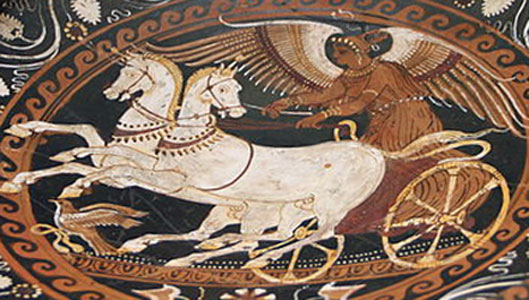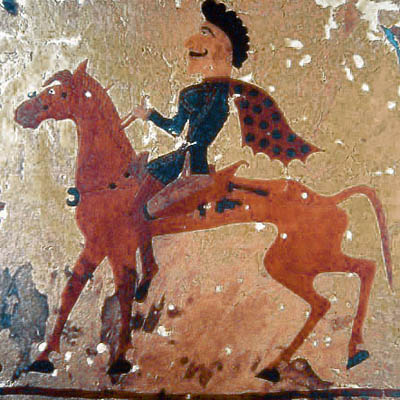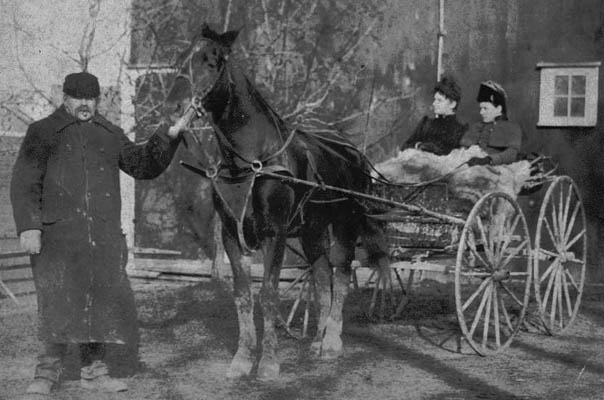So, You Think You Love Horses?
Some Reflections on the Nature of Horses and Man
More Discussions by “The Accidental Horseman”
The Historical Importance and Evolution of Horse Harnessing
Most riders today seem to be more focused on mounted riding and have less interest in driven horses. I have never been involved in harnessing a horse and have little familiarity with the terminology. This lack of familiarity is not just mine but extends to the general public as well. One hundred years ago and before the motor car gained ascendance, most people would have been very familiar with how harnesses worked and experienced horse-draw vehicles in their daily lives.
Chariot Depicted on a Apulian Patera (Tray)
(Courtesy of Giovanni Dall'Orto and the Museo Archeologico di Milano

|
Once horses were domesticated by man, the obvious question became what can we do with this animal that might be beneficial to us. Horses were domesticated by steppes peoples who practiced little agriculture and relied more on trading, raiding and herding to get food stuffs. About 3000 B.C.E. the Yamnaya people of the Pontic–Caspian steppe discovered that horses could pull sleds and wheeled vehicles and they used those to move their heavier household items. From these crude wheeled vehicles came the chariot, which revolutionized warfare in that it provided a fast and stable fighting platform. Chariots were adopted by the surrounding cultures and launched an intense arms race that led to ever improving designs. The rapid innovation of airplane design in our own times was very similar to what happened with the chariot in ancient times. The major a limitation of chariots were that the warrior needed another man as a driver and sometimes even a third who held a shield, protecting the other two and removing potential fighting men from the army. Also in there was the vulnerability of the horses, being placed forward of the chariot as they were. With the introduction of saddles and refinement in tactics, mounted warriors were able to outplace the expensive chariots. A rug with from a burial mount of the Pazyrick culture depicts a mounted horseman and is shown below. More detailed images show detailed aspects of the horse's tack. It is wearing a breast collar not dissimilar to ones use use today. Chariots quickly disappeared from battlefields, but the improvements in wheeled vehicle designs persisted.
Pazyrik Horseman: Circa 300 B.C.E (State Hermitage Museum, St. Petersburg)
Notice no stirrups, a saddle supported by a breast plate,
reins in left hand but over the horse's right neck and a sophisticated headstall

|
One undesirable aspect of ancient harnesses designs persisted. They were of a throat and girth design that pressed on the horse windpipe and severely limited the animal’s pulling power. The Chinese are believed to have first developed the padded horse collar, which put the weight of the load against the horse’s shoulders and freed the windpipe, allowing the animal to pull heavier loads. This new technology slowly spread across Eurasia and unlocked a revolution in horse power that was beneficial to both agriculture and commerce.
For millennium teams of oxen were the primary plow animal. However, even one horse was much more effective than a team of oxen as a plow animal. Perhaps, the major drawback was that a horse would have been too costly for the average farmer to acquire. However, they were not beyond the means of the average landowning lord of the manor. The lords made arrangements with their tenants; such that teams of horses owned by the lord were rotated among the tenants for their use. Even today modern farmers have similar arrangements with respect to expensive equipment that are not used on a daily basis. Agricultural output and population sizes increased dramatically as a result.
A Horse Harnessed with a Breast Collar and Poles Rather than Traces

|
Europe in particular had had a network of good Roman-built roads that had survived the test of time. Carts, wagons and coaches with their new and improved harnessing were able to transport heavier loads over longer distances, supplementing water transport, which was not infrequently choked off by medieval robber barons. Coupled with improvements in literacy, the printing press, the growth of the middle and commercial classes, improvements in education and other developments too numerous to mention, mankind found itself on the brink of modern times. We need to give much credit to our unsung partner in all of this, the horse.
Truly Yours, The Accidental Horseman.
Back to Additional Discussions
Links to Other Sites regarding Horses
Back to Index Page



